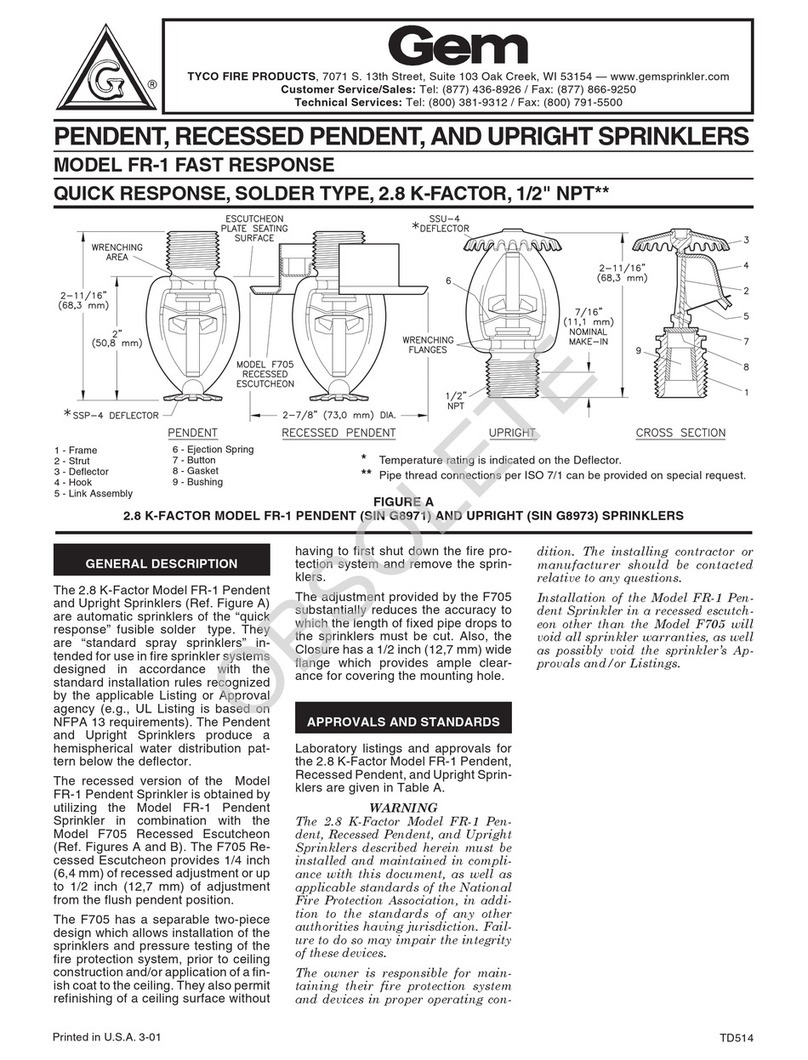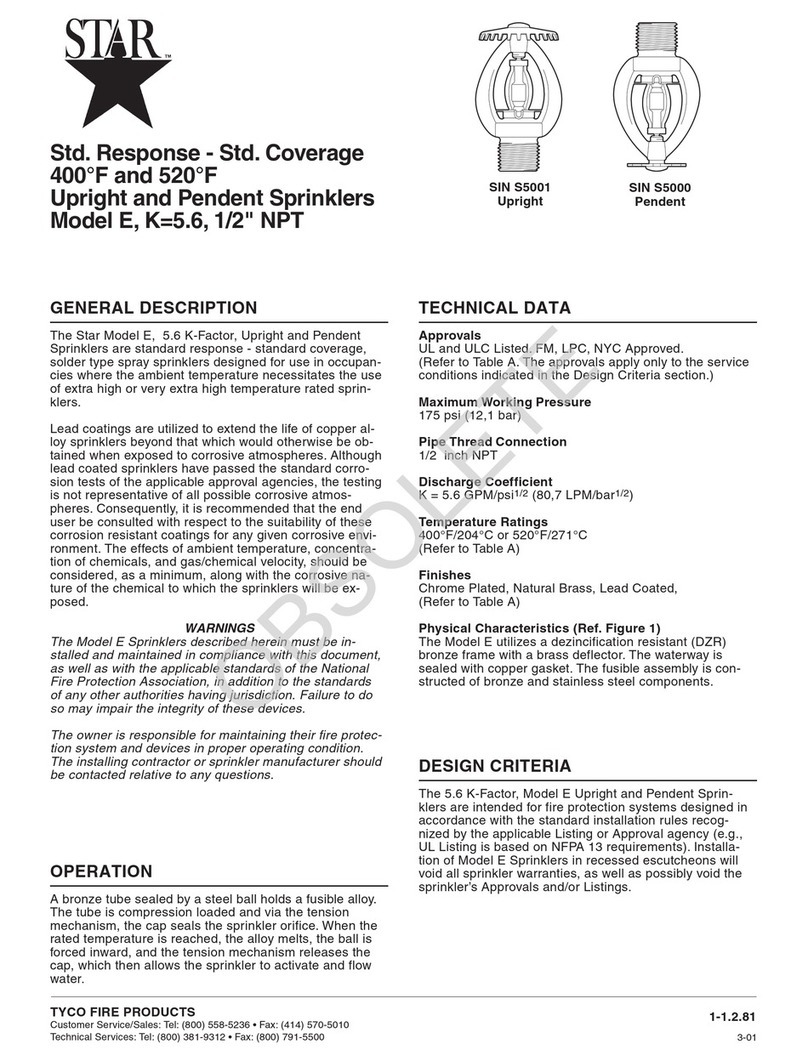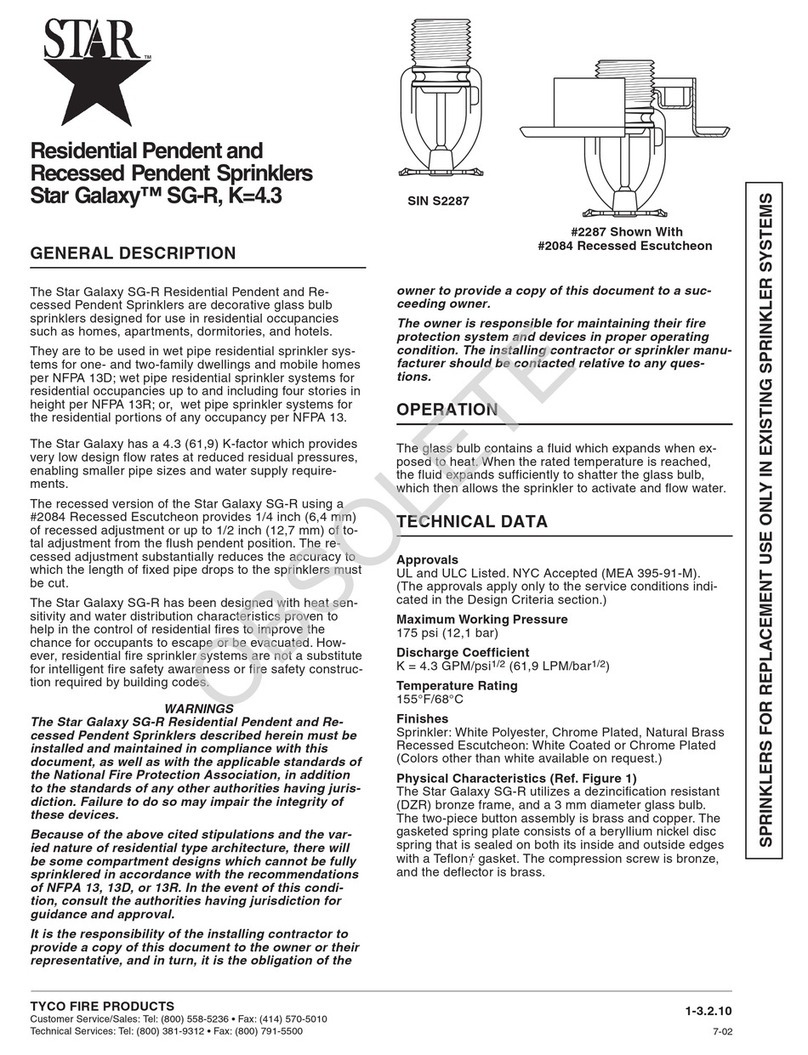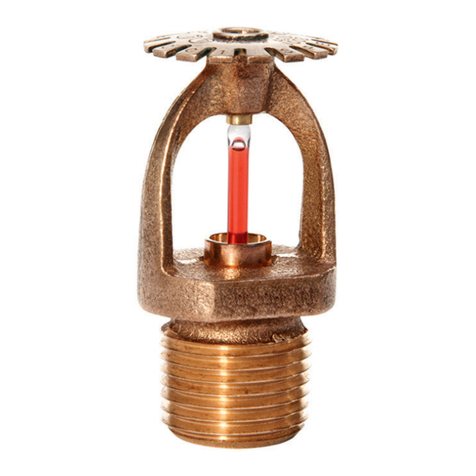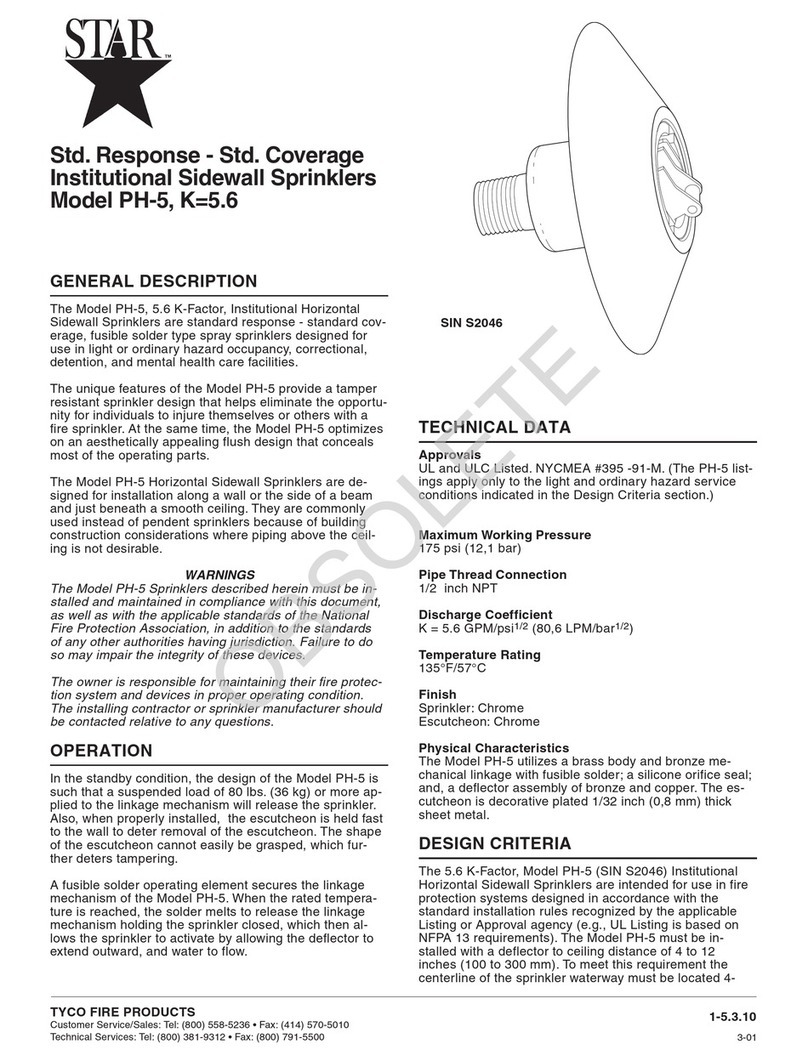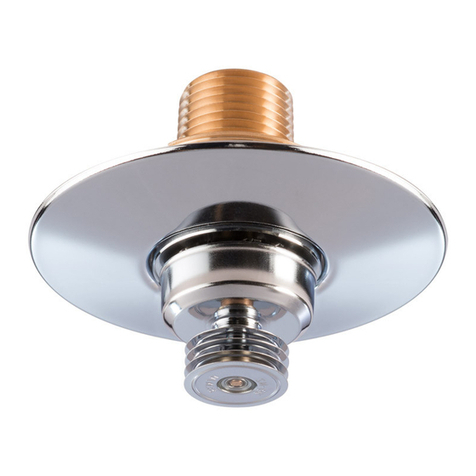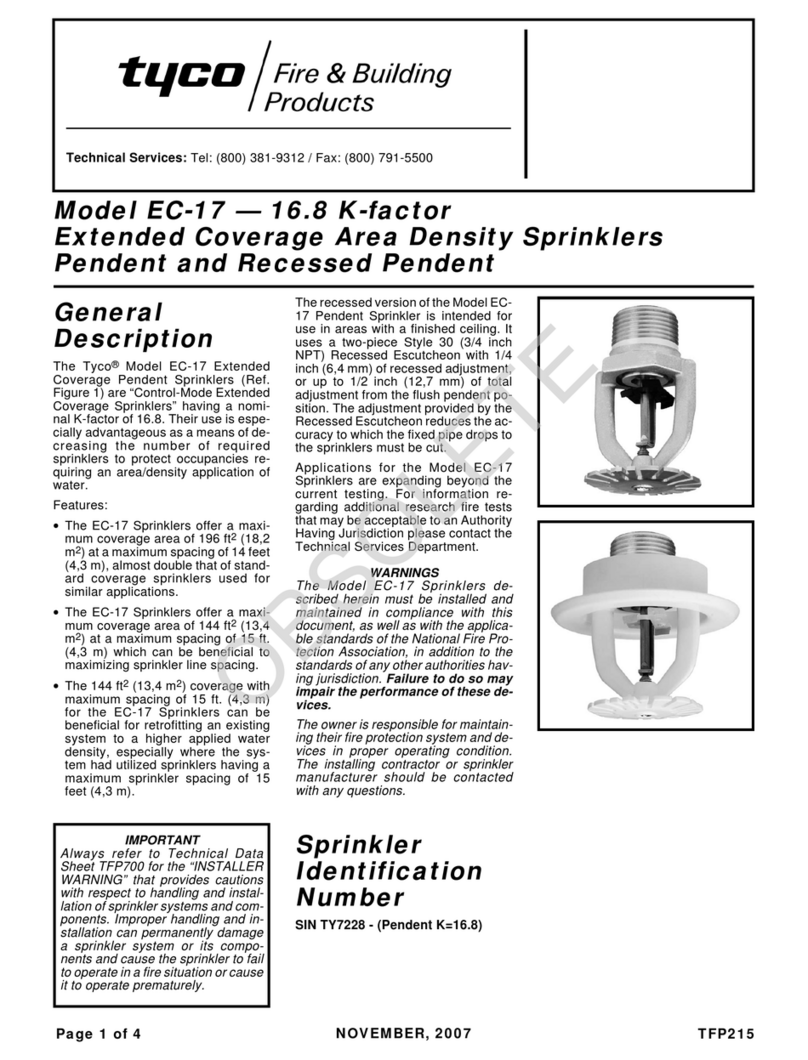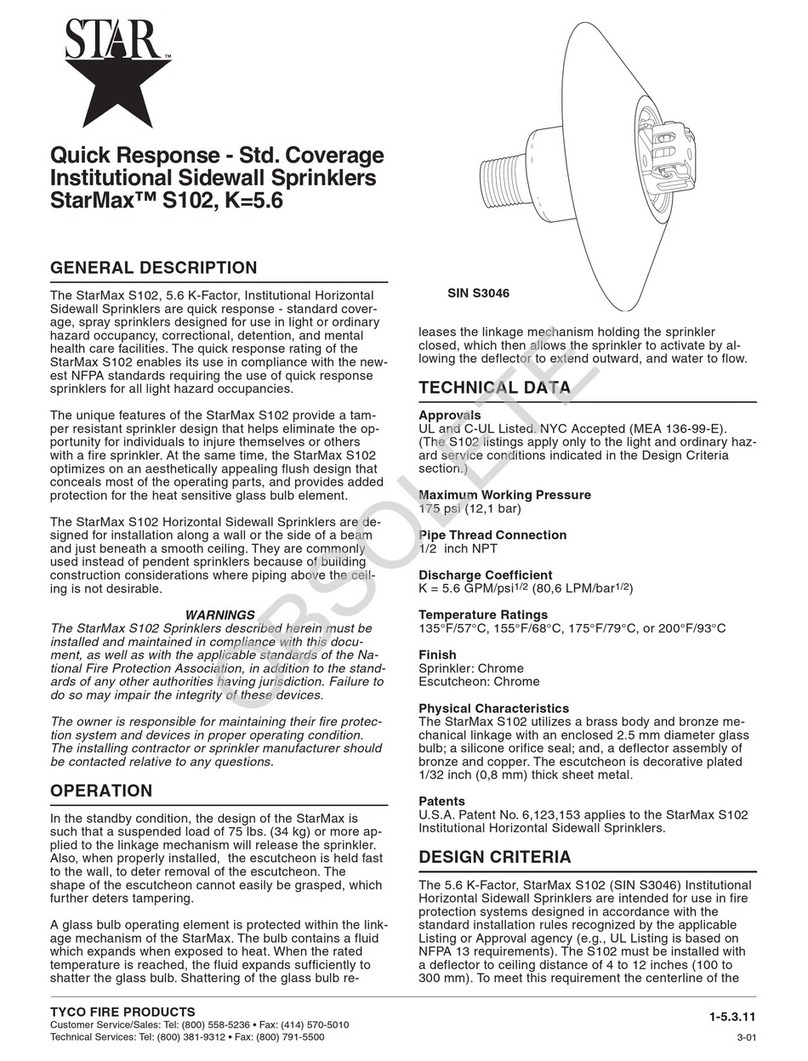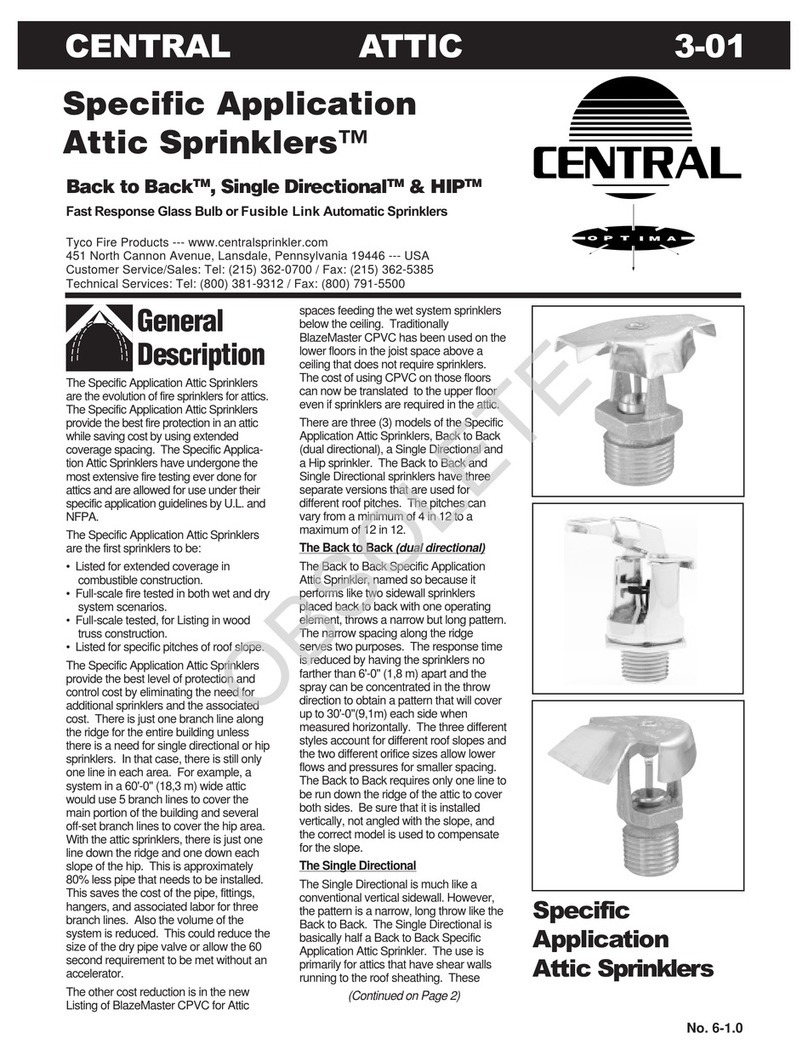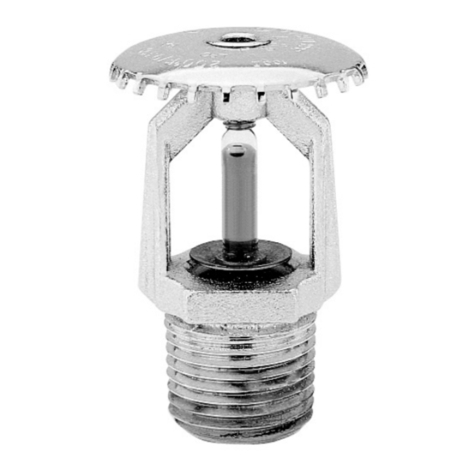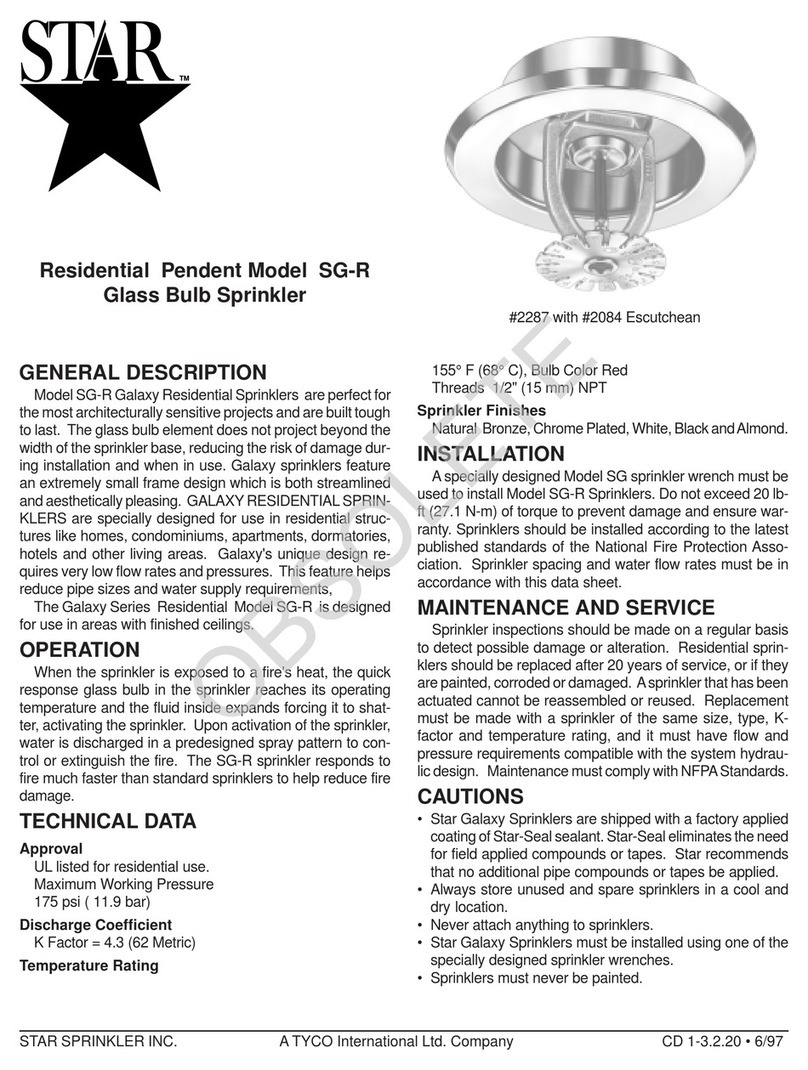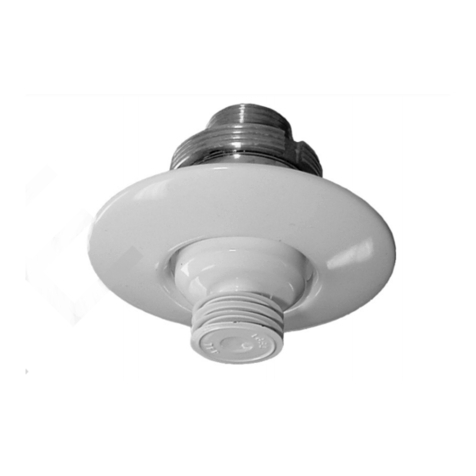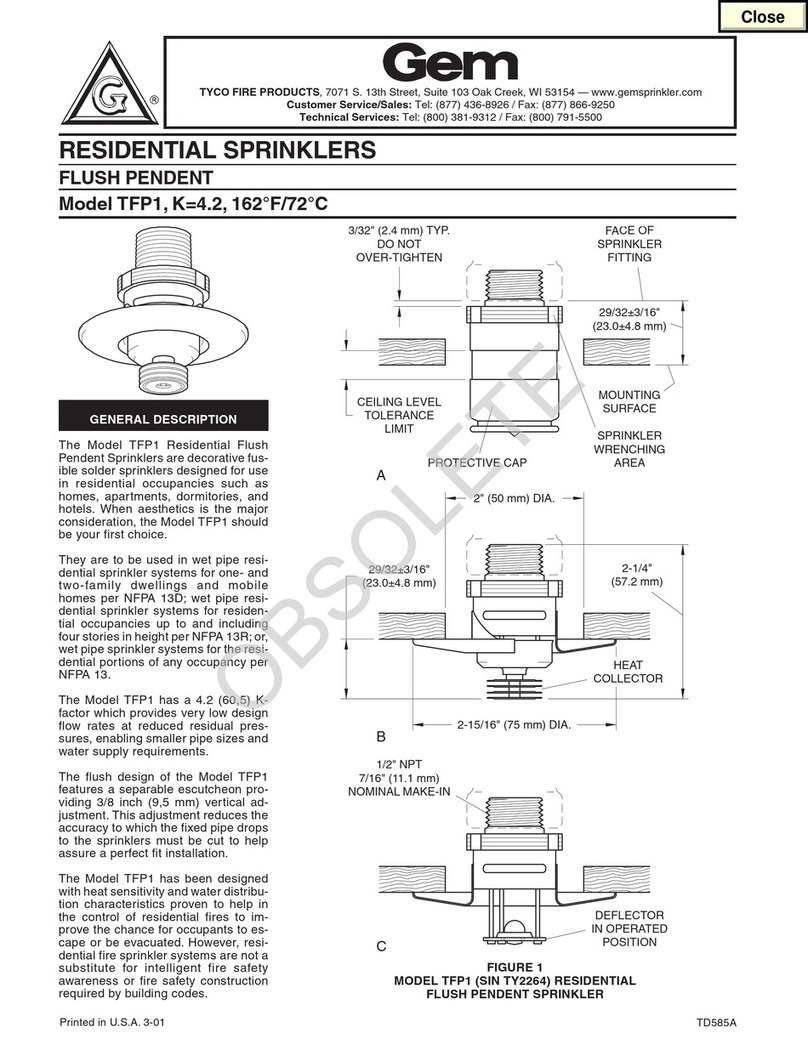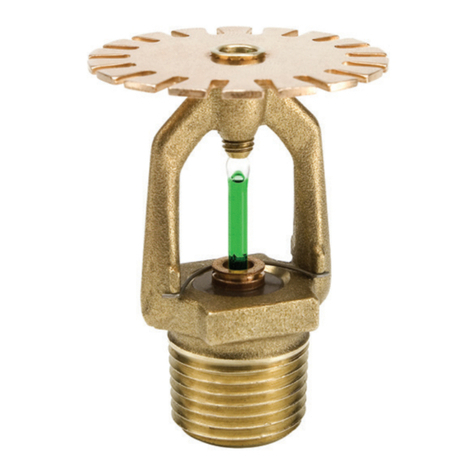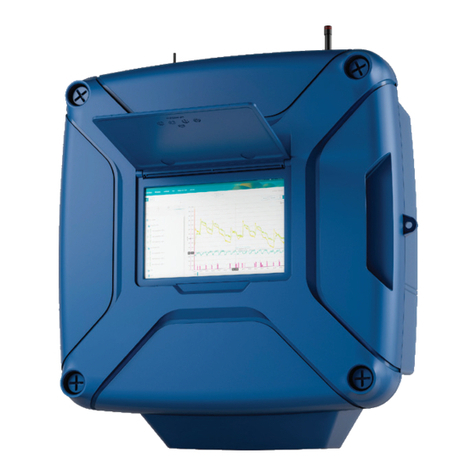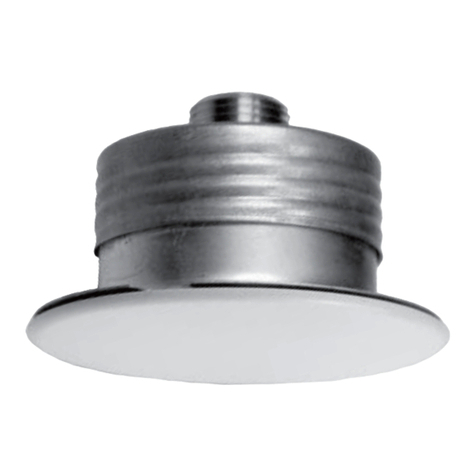
leakage or impairment of the sprinkler.
Do not attempt to make-up for insuffi-
cient adjustment in the escutcheon
plate by under- or over-tightening the
sprinkler. Readjust the position of the
sprinkler fitting to suit.
The Series TY-B Pendent and Up-
right Sprinklers must be installed in
accordance with the following instruc-
tions.
Step 1. Pendent sprinklers are to be
installed in the pendent position, and
upright sprinklers are to be installed in
the upright position.
Step 2. With pipe thread sealant ap-
plied to the pipe threads, hand tighten
the sprinkler into the sprinkler fitting.
Step 3. Tighten the sprinkler into the
sprinkler fitting using only the W-Type
6 Sprinkler Wrench (Ref. Figure 7),
except that an 8 or 10 inch adjustable
Crescent wrench is to be used for wax
coated sprinklers. With reference to
Figures 1, 2, 3, and 4 the W-Type 7
Sprinkler Wrench or the adjustable
Crescent wrench, as applicable is to
be applied to the wrench flats.
When installing wax coated sprinklers
with the adjustable Crescent wrench,
additional care needs to be exercised
to prevent damage to the wax coating
on the sprinkler wrench flats or frame
arms and, consequently, exposure of
bare metal to the corrosive environ-
ment. The jaws of the wrench should
be opened sufficiently wide to pass
over the wrench flats without damag-
ing the wax coating. Before wrench
tightening the sprinkler, the jaws of the
wrench are to be adjusted to just con-
tact the sprinkler wrench flats. After
wrench tightening the sprinkler, loosen
the wrench jaws before removing the
wrench.
After installation, the sprinkler wrench
flats and frame arms must be in-
spected and the wax coating re-
touched (repaired) whenever the coat-
ing has been damaged and bare metal
is exposed. The wax coating on the
wrench flats can be retouched by gen-
tly applying a heated 1/8 inch diameter
steel rod to the areas of wax that have
been damaged, to smooth it back over
areas where bare metal is exposed.
NOTES
Only retouching of the wax coating ap-
plied to the wrench flats and frame
arms is permitted, and the retouching
is to be performed only at the time of
the initial sprinkler installation.
The steel rod should be heated only to
the point at which it can begin to melt
the wax, and appropriate precautions
need to be taken, when handling the
heated rod, in order to prevent the
installer from being burned.
The Series TY-B Recessed Pendent
Sprinklers must be installed in ac-
cordance with the following instruc-
tions.
Step A. After installing the Style 10 or
40 Mounting Plate, as applicable, over
the sprinkler threads and with pipe
thread sealant applied to the pipe
threads, hand tighten the sprinkler into
the sprinkler fitting.
Step B. Tighten the sprinkler into the
sprinkler fitting using only the W-Type
7 Recessed Sprinkler Wrench (Ref.
Figure 8). With reference to Figure 3
or 4, the W-Type 7 Recessed Sprinkler
Wrench is to be applied to the sprinkler
wrench flats.
Step C. After the ceiling has been in-
stalled or the finish coat has been ap-
plied, slide on the Style 10 or 40 Clo-
sure over the Series TY-B Sprinkler
and push the Closure over the Mount-
ing Plate until its flange comes in con-
tact with the ceiling.
Care and
Maintenance
The Series TY-B Sprinklers must be
maintained and serviced in accord-
ance with the following instructions:
NOTES
Before closing a fire protection system
main control valve for maintenance
work on the fire protection system that
it controls, permission to shut down the
affected fire protection system must be
obtained from the proper authorities
and all personnel who may be affected
by this action must be notified.
The owner must assure that the sprin-
klers are not used for hanging of any
objects; otherwise, non-operation in
the event of a fire or inadvertent opera-
tion may result.
Absence of an escutcheon, which is
used to cover a clearance hole, may
delay the time to sprinkler operation in
a fire situation.
Sprinklers that are found to be leaking
or exhibiting visible signs of corrosion
must be replaced.
Automatic sprinklers must never be
painted, plated, coated or otherwise
altered after leaving the factory. Modi-
fied sprinklers must be replaced.
Sprinklers that have been exposed to
corrosive products of combustion, but
have not operated, should be replaced
if they cannot be completely cleaned
by wiping the sprinkler with a cloth or
by brushing it with a soft bristle brush.
Care must be exercised to avoid dam-
age to the sprinklers - before, during,
and after installation. Sprinklers dam-
aged by dropping, striking, wrench
twist/slippage, or the like, must be re-
placed. Also, replace any sprinkler
that has a cracked bulb or that has lost
liquid from its bulb. (Ref. Installation
Section).
Frequent visual inspections are rec-
ommended to be initially performed for
corrosion resistant coated sprinklers,
after the installation has been com-
pleted, to verify the integrity of the cor-
rosion resistant coating. Thereafter,
annual inspections per NFPA 25
should suffice; however, instead of in-
specting from the floor level, a random
sampling of close-up visual inspec-
tions should be made, so as to better
determine the exact sprinkler condi-
tion and the long term integrity of the
corrosion resistant coating, as it may
be affected by the corrosive conditions
present.
The owner is responsible for the in-
spection, testing, and maintenance of
their fire protection system and de-
vices in compliance with this docu-
ment, as well as with the applicable
standards of the National Fire Protec-
tion Association (e.g., NFPA 25), in
addition to the standards of any other
authorities having jurisdiction. The in-
stalling contractor or sprinkler manu-
facturer should be contacted relative
to any questions.
It is recommended that automatic
sprinkler systems be inspected,
tested, and maintained by a qualified
Inspection Service in accordance with
local requirements and/or national
codes.
TFP151 Page 7 of 8
TFP151_EN Page 7 of 8
over the wrench ats without damaging
the wax coating. Before wrench tightening
the sprinkler, the jaws of the wrench are to
be adjusted to just contact the sprinkler
wrench ats. After wrench tightening the
sprinkler, loosen the wrench jaws before
removing the wrench.
After installation, the sprinkler wrench ats
and frame arms must be inspected and the
wax coating retouched (repaired) whenev-
er the coating has been damaged and bare
metal is exposed. The wax coating on the
wrench ats can be retouched by gently
applying a heated 1/8 inch diameter (M3)
steel rod to the areas of wax that have been
damaged, to smooth it back over areas
where bare metal is exposed.
NOTES
Only retouching of the wax coating applied to
the wrench ats and frame arms is permitted,
and the retouching is to be performed only at
the time of the initial sprinkler installation.
The steel rod should be heated only to the
point at which it can begin to melt the wax,
and appropriate precautions need to be tak-
en, when handling the heated rod, in order to
prevent the installer from being burned.
The Series TY-B Recessed Pendent Sprin-
klers must be installed in accordance with
the following instructions.
Step A. After installing the Style 10 or 40
Mounting Plate, as applicable, over the
sprinkler threads and with pipe thread seal-
ant applied to the pipe threads, hand tight-
en the sprinkler into the sprinkler tting.
Step B. Tighten the sprinkler into the
sprinkler tting using only the W-Type 7
Recessed Sprinkler Wrench (Ref. Figure 8).
With reference to Figure 3 or 4, the W-Type
7 Recessed Sprinkler Wrench is to be ap-
plied to the sprinkler wrench ats.
Step C. After the ceiling has been installed
or the nish coat has been applied, slide on
the Style 10 or 40 Closure over the Series
TY-B Sprinkler and push the Closure over
the Mounting Plate until its ange comes in
contact with the ceiling.
Care and
Maintenance
The Series TY-B Sprinklers must be main-
tained and serviced in accordance with the
following instructions:
NOTES
Before closing a re protection system main
control valve for maintenance work on the
re protection system that it controls, permis-
sion to shut down the aected re protection
systems must be obtained from the proper
authorities and all personnel who may be af-
fected by this action must be notied.
The owner must assure that the sprinklers are
not used for hanging of any objects; other-
wise, non-operation in the event of a re or
inadvertent operation may result.
Absence of an escutcheon, which is used to
cover a clearance hole, may delay the time to
sprinkler operation in a re situation.
Sprinklers that are found to be leaking or
exhibiting visible signs of corrosion must
be replaced.
Automatic sprinklers must never be paint-
ed, plated, coated, or otherwise altered af-
ter leaving the factory. Modied sprinklers
must be replaced. Sprinklers that have
been exposed to corrosive products of
combustion, but have not operated, should
be replaced if they cannot be completely
cleaned by wiping the sprinkler with a cloth
or by brushing it with a soft bristle brush.
Care must be exercised to avoid damage
to the sprinklers - before, during, and after
installation. Sprinklers damaged by drop-
ping, striking, wrench twist/slippage, or
the like, must be replaced. Also, replace any
sprinkler that has a cracked bulb or that has
lost liquid from its bulb. (Ref. Installation
Section).
Frequent visual inspections are recom-
mended to be initially performed for corro-
sion resistant coated sprinklers, after the in-
stallation has been completed, to verify the
integrity of the corrosion resistant coating.
Thereafter, annual inspections per NFPA 25
should suce; however, instead of inspect-
ing from the oor level, a random sampling
of close-up visual inspections should be
made, so as to better determine the exact
sprinkler condition and the long term in-
tegrity of the corrosion resistant coating, as
it may be aected by the corrosive condi-
tions present.
The owner is responsible for the inspection,
testing, and maintenance of their re pro-
tection system and devices in compliance
with this document, as well as with the
applicable standards of the National Fire
Protection Association (e.g. NFPA 25), in ad-
dition to the standards of any other author-
ities having jurisdiction. The installing con-
tractor or sprinkler manufacturer should be
contacted relative to any questions.
It is recommended that automatic sprinkler
systems be inspected, tested, and main-
tained by a qualied Inspection Service in
accordance with local requirements and/or
national codes.
Limited
Warranty
Products manufactured byTyco Fire & Build-
ing Products (TFBP) are warranted solely to
the original Buyer for ten (10) years against
defects in material and workmanship when
paid for and properly installed and main-
tained under normal use and service. This
warranty will expire ten (10) years from
date of shipment by TFBP. No warranty is
given for products or components manu-
factured by companies not aliated by
ownership with TFBP or for products and
components which have been subject to
misuse, improper installation, corrosion, or
which have not been installed, maintained,
modied or repaired in accordance with ap-
plicable Standards of the National Fire Pro-
tection Association, and/or the standards
of any other Authorities Having Jurisdic-
tion. Materials found by TFBP to be defec-
tive shall be either repaired or replaced, at
TFBP’s sole option. TFBP neither assumes,
nor authorizes any person to assume for it,
any other obligation in connection with the
sale of products or parts of products. TFBP
shall not be responsible for sprinkler system
design errors or inaccurate or incomplete
information supplied by Buyer or Buyer’s
representatives.
In no event shall TFBP be liable, in contract,
tort, strict liability or under any other le-
gal theory, for incidental, indirect, special
or consequential damages, including but
not limited to labor charges, regardless of
whether TFBP was informed about the pos-
sibility of such damages, and in no event
shall TFBP’s liability exceed an amount
equal to the sales price.
The foregoing warranty is made in lieu of
any and all other warranties express or
implied, including warranties of merchant-
ability and tness for a particular purpose.
This limited warranty sets forth the exclu-
sive remedy for claims based on failure of
or defect in products, materials or compo-
nents, whether the claim is made in con-
tract, tort, strict liability or any other legal
theory.
This warranty will apply to the full extent
permitted by law. The invalidity, in whole or
part, of any portion of this warranty will not
aect the remainder.
